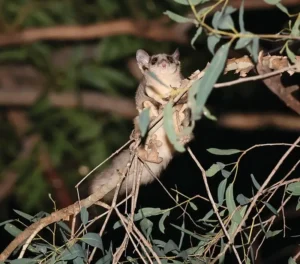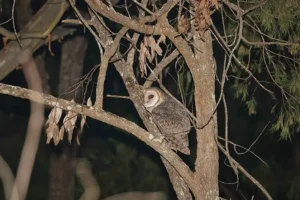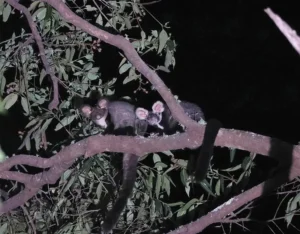
The 2023 Christmas Day superstorm damaged many Land for Wildlife properties in the Gold Coast and Scenic Rim regions with trees ripped from the ground and debris widely scattered.
As part of the damage assessment, Scenic Rim Regional Council engaged local ecologists to conduct nocturnal surveys to see how our threatened animals were faring, with a focus on trying to find Koalas, Greater Gliders and large forest owls. Potentially, these species could have been killed or injured during the storm. The gliders and owls need large hollows to shelter and breed in, and we were worried that lots of their homes might have also been damaged or blown to the ground.
The results of the surveys were surprisingly reassuring. On one severely damaged Tamborine Mountain property, a single nocturnal survey found Greater Gliders, an Australian Masked Owl, Southern Boobooks, a Koala, a Tawny Frogmouth and Sugar Gliders. Despite the decimation of some of their habitat, these creatures survived the storm and are now attempting to adapt to the modified ecosystem they inhabit.

Frogs seemed unperturbed by the storm damage and thrived in the hot and wet January weather. The spotlighting surveys observed eight species of frog on a Tamborine Land for Wildlife property including the uncommon Green-thighed Frog and Dusky Gungun.
To our relief, Greater Gliders were present at two other badly damaged properties. They were found a small distance from their last known location on the properties. They were previously found along ridges lined with large remnant eucalypts, but the storm had knocked most of these eucalypts down and the surviving trees were left leafless.
Supported by the Scenic Rim Regional Council’s Environmental Grants Program, several storm-damaged Land for

Wildlife properties have installed large nest boxes designed for Greater Gliders. Hopefully they will provide some supplementary shelter and breeding sites while the forest recovers.
Article by Catherine Madden
Land for Wildlife Officer
Scenic Rim Regional Council and
Greg Tasney, Consultant Ecologist
Photos by Greg Tasney
